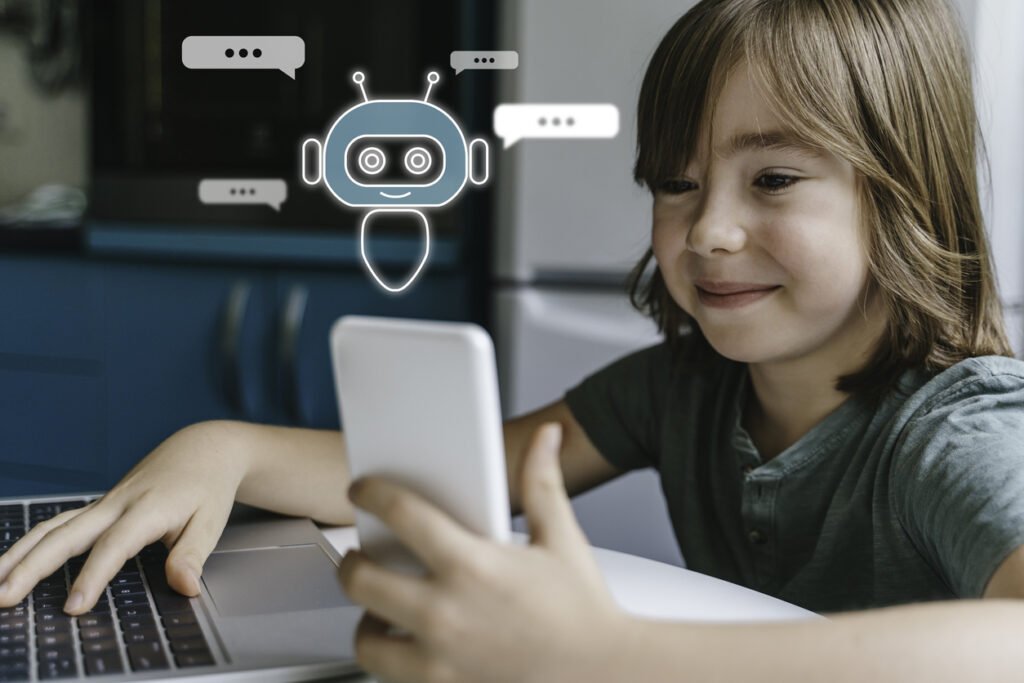As schools end the academic year and look ahead to the 24-25 school year, many are likely still trying to determine the best strategies for realizing the potential benefits and overcoming the challenges related to artificial intelligence (AI) technologies. To do so, schools should consider taking a structured approach to AI integration based on the current state and needs of their own staff and stakeholders. Michigan Virtual’s AI Integration Framework for School Districts provides a lens through which school districts can assess their current capacity and determine goals for their integration efforts. This blog post provides more specific details for planning and implementation according to our AI Integration Process.
Initiate
Hold awareness sessions
The first and possibly most crucial step in AI integration is to ensure that all stakeholders—teachers, administrators, parents, and students—understand what AI is and its potential impact on education. Schools should survey their staff to determine what they already know and may already be doing with AI, then organize awareness sessions to demystify AI, addressing common misconceptions and highlighting its benefits and limitations. These sessions can lay the groundwork for a more informed and receptive community.
Form an advisory team
Creating a dedicated advisory team is critical for guiding the AI integration process. This team could include educators, technology specialists, administrators, students, and community members. It may also be beneficial to include early adopters of AI technologies who can model appropriate and beneficial use for the broader school community. The advisory team’s role will be to provide diverse perspectives, oversee the development and implementation of AI initiatives, and ensure alignment with educational goals and values.
Develop policies and guidelines
Developing clear policies and guidelines is essential to address ethical considerations, data privacy, and the responsible use of AI. Schools should draft comprehensive guidance that sets boundaries and expectations for AI use, ensuring these guidelines are transparent and accessible to all stakeholders. Michigan Virtual’s Sample Guidance on Staff Use of Generative AI for K-12 School Districts may be a good place to develop guidance specifically for staff.
Explore tools
Before diving into full-scale implementation, schools should explore and pilot various AI tools and platforms. This exploratory phase allows educators to identify platforms that best suit their teaching methods and learning objectives. Some tools that have seen increased adoption and may be worth exploring include Brisk Teaching, Khanmigo, MagicSchool, and SchoolAI. Pilot programs should provide insight into whether tools are delivering their intended results and moving the needle on goals that school districts already have in place.
Build
Provide professional development
Building on their initial awareness sessions, schools should offer ongoing training sessions to equip teachers with the knowledge and skills needed to use AI tools effectively. These sessions should cover both technical aspects and pedagogical strategies, ensuring that educators are confident and competent in using AI.
Refine guidelines with broad input
As AI tools are piloted and initial feedback is gathered, refining the guidelines is essential. To ensure that the policies are comprehensive and inclusive, input should be sought from a wide range of stakeholders, including teachers, students, and parents.
Adapt assessment strategies
AI presents several challenges and opportunities when it comes to the assessment of student learning. Schools should have curriculum and assessment teams determine which current assessment methods require updating to account for student use of AI and consider how frameworks like the AI Assessment Scale may be integrated to ensure appropriate and effective student use of AI tools.
Engage
Begin AI literacy efforts in classrooms
Introducing AI literacy in classrooms is crucial for preparing students for a future where AI will play a significant role. Schools should integrate AI-related content into the curriculum, teaching students about the basics of AI, its applications, and ethical considerations. These efforts will help students become informed and responsible users of AI technology. Resources from Common Sense Media, Stanford University, Digital Promise, Day of AI, and other organizations can provide great starting points for districts looking to build the AI literacy of their students.
Share & implement guidelines with students and families
Transparent communication with students and families about AI policies and guidelines is vital. Schools should share these guidelines through various channels and ensure that everyone understands the expectations and benefits of AI integration. This inclusive approach fosters a supportive and collaborative environment.
Provide ongoing training
Because AI technologies are rapidly developing and are novel in school settings, integration will be an evolving process. Ongoing training is necessary to keep educators up-to-date with the latest developments and findings. Schools should offer continuous professional development opportunities, encouraging educators to stay informed and adapt to new AI tools and methodologies.
Evaluate
Identify & share promising practices
As AI tools and strategies are implemented, it’s important to identify and share promising practices. Schools should create platforms for their advisory committees and individual teachers to share their experiences, successes, and challenges. This collaborative approach helps build a repository of effective AI practices that can be replicated and scaled.
Update policies & guidelines as needed
As the technology evolves and more insights are gained from its adoption, policies and guidance must be flexible to accommodate new developments. Schools should regularly review and update their AI guidelines to remain relevant and effective. This iterative process allows for continuous improvement and adaptation.
Monitor adoption of tools & strategies
Monitoring the adoption and impact of AI tools and strategies is essential for assessing their effectiveness. Schools should establish metrics and evaluation processes to track progress and make data-driven decisions. Regular feedback loops can help fine-tune AI integration efforts and ensure they meet educational objectives.
By following Michigan Virtual’s AI Integration Framework, school districts can systematically incorporate AI technologies into their educational practices, ensuring that integration is intentional, inclusive, and adaptable. Prioritizing collaboration, transparency, and ongoing professional development, districts can create dynamic learning environments that leverage AI to enhance student outcomes and prepare them for the future. Embracing AI with careful planning and continuous engagement will position districts to unlock its full potential, fostering a more innovative and effective educational experience for all stakeholders.

